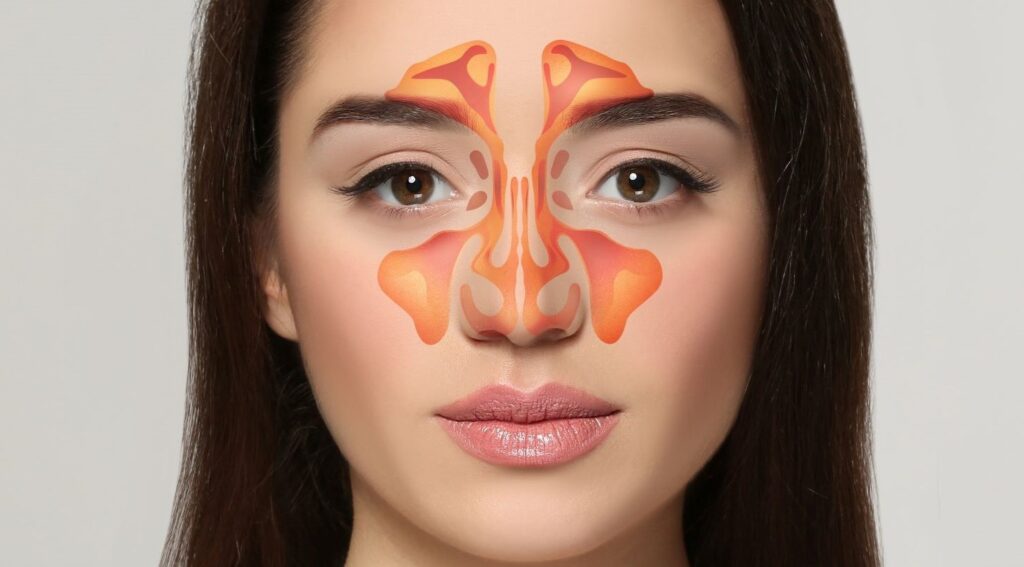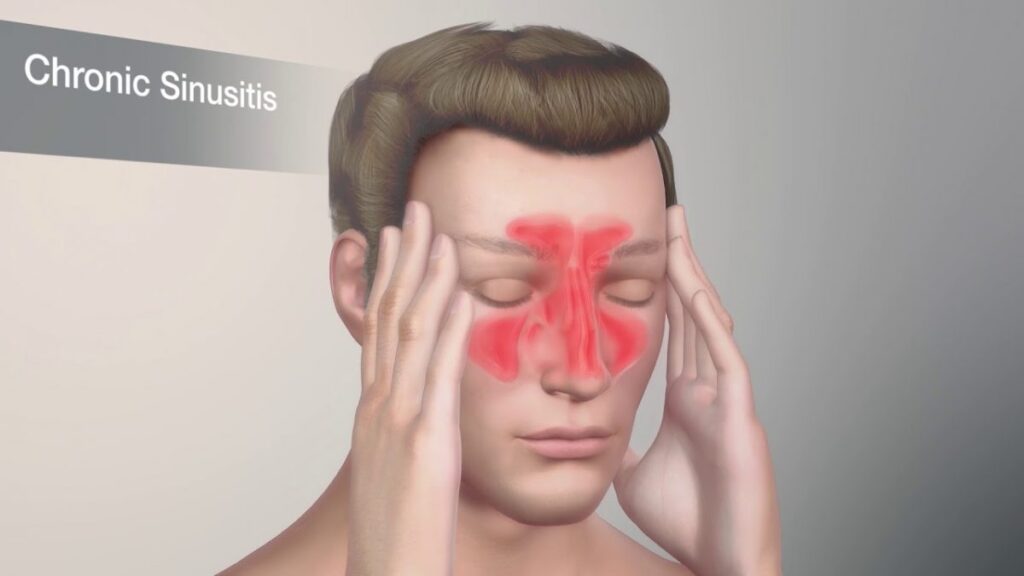How to “Read” a CT Scan:
Some brief instructions on reading sinus CT scans: black is air; white is bone; gray is “soft tissue,” or everything else – brain, eyeball, cheek tissue, thickened sinus lining, or snot, or even pus.
Warning … Danger, Will Robinson …
Complications of sinusitis are rare, but they can have horrible outcomes if not treated promptly, aggressively, and with skill. The following review describes what can go wrong, what some of the signs and symptoms are, and when you need to seek medical help, like right now.
For those of you who are too young to know, the robot at the right (“B9″) was a regular feature on “Lost in Space” from the mid-1960′s. You can buy a full-sized replica for only $25,000. Seriously, people buy them. There are now several websites devoted to the B9 robot and the Lost in Space series. I just can’t imagine being so nostalgic for a TV series that I would spend $25 grand for one of these. It’s not like it will vacuum the floor or fetch you a beer.
See Also: buy cpap m`ask online
Complications of Sinusitis
Intracranial Complications of Sinusitis:
The ethmoid, frontal, and sphenoid sinuses are separated from the brain by only a thin layer of bone. If infection – sinusitis – passes through these bones it can infect the fluid and tissues that surround the brain, resulting in meningitis (1). If the infection enters the brain tissue it can cause an abscess (2), or walled-off infection. Inflammation of the intracranial blood vessels can result in abnormal clotting (thrombosis) of blood vessels inside the skull (3). This, in turn, can cause blindness, brain swelling, stroke, and death. Stress-point: intracranial complications can be fatal.

Forehead Abscess (“Pott’s Puffy Tumor”) Complicating Sinusitis
Case #1
This teenage boy had 2 rare complications of sinusitis: extension of the infection to form an abscess in his forehead (“Pott’s Puffy Tumor”), and intracranial extension to form a brain abscess:
You can see from the photo on the right that his forehead looks like he is hiding a golf ball. This abscess is very tender. He rapidly developed “mental status changes” (he was irritable and lethargic), and an emergency MRI revealed that the infection in the forehead had eroded through the bone of the anterior skull to form a brain abscess:
Forehead Abscess That Extends Through Skull to Form Brain Abscess
This young man required emergency surgery to drain both his forehead abscess and his brain abscess, as well as to remove all of the infected tissue (mostly polyps) within his sinuses that caused the problem in the first place. He recovered fully.
Summary:
Any of these infections – meningitis, brain abscess, thrombosis (blood clot)– can be life threatening. They require urgent and aggressive treatment. When these complications are suspected, an MRI is usually obtained, sometimes in addition to a CT scan.
These patients require hospitalization, with possible consultation of multiple specialists including neurosurgeon, ophthalmologist, otolaryngologist (ENT), and infectious disease experts. Many will require urgent surgery.
Anyone with sinusitis who exhibits changing mood or mental abilities, sudden and severe irritability, lethargy, or difficulty speaking, walking, or managing fine motor skills, must be evaluated by a physician. Right Now.
Orbital Complications of Sinusitis:
The ethmoid sinuses fill the space between the eye sockets (“orbits”), and the maxillary sinuses in the bones of the cheeks form the floors of the orbits. Again, these sinuses are separated from the orbits by only a thin layer of bone. If infection from sinusitis in these sinuses passes through these bones, orbital abscess (4) or infection (orbital cellulitis, 5) in the orbit can result in blindness.
Case #2
The photo below shows a 6-year old boy with a recent history of a “cold” – a viral URI. Over the past 24 hours his right eye is drooping, he complains of double vision. On exam, his eye does not move easily, seems to be looking down.
A CT scan of his sinuses reveals a small abscess just inside his right eye socket (orange arrow). This causes inflammation and compression of one of the eye muscles (medial rectus) that moves the eye (dashed orange line). This often requires surgery to cure.
Case #3
The photo below is from a 6-year old girl with an identical story. Her eye actually looks worse, with redness and swelling so that she cannot easily open her left eye.
A CT scan of her sinuses shows “stuff” in the ethmoid sinuses next to her left eye, but there is no abscess. She has “peri-orbital cellulitis,” or infection of the tissues around the eye. This improved with intravenous antibiotics, no surgery.
Case #4
Different patient: The MRI shown on the right shows a life-threatening complication of sinusitis. This complication is also a risk for blindness. It shows an MRI from a teenage girl with severe sinusitis. The complication is clotting of the veins of her left eye, and clotting of a large venous area inside the skull – the cavernous sinus (orange arrows).
She was hospitalized for intravenous antibiotics for severe sinusitis, and otitis. When she began to complain of vision changes this MRI was obtained. Visual testing revealed that she was losing the sight in her left eye.
She was taken to emergency surgery for sinus surgery, mostly to decompress her left orbit to relieve pressure on her eye and optic nerve.
Although she had a very difficult hospitalization and required several surgeries and long-term antibiotics, and anti-clotting medications, she recovered fully. Her vision is perfect, and unchanged. [Aside: after leaving the hospital, she brought me huckleberry turnovers that she had baked herself every time she saw me in clinic, for years!] Her story is described in the first journal paper listed in Resources, below.
Summary:
These patients usually require hospitalization, with consultation of ophthalmologist, otolaryngologist, neurosurgeon, and infectious disease experts. Many will require urgent surgery.
Anyone with sinusitis who experiences ANY change in vision (double vision, blurring of vision, difficulty seeing in any way), or bulging of one or both eyes, must be evaluated by a physician. Right Now.

Local Complications of Sinusitis:
Sinus Polyps, Complication of Sinusitis, Chronic Rhinitis
Polyps (6):
Chronic inflammation from sinusitis can be associated with sinus and nasal polyps. These are abnormal swellings of the lining. Polyps can cause nasal obstruction, making nasal breathing difficult or impossible. Polyps can also block the sinus openings, causing worsening of sinusitis. Chronic growth of polyps can push bone out of place and cause distortion of the nasal profile – how the nose looks from the outside. Obstruction from polyps can also cause loss of smell. Finally, recurrent and chronic sinusitis can cause permanent loss of smell due to injury of the olfactory nerves. Children with cystic fibrosis are at increased risk for sino-nasal polyps.
Mucoceles (7):
Obstruction of the sinus opening from chronic inflammation can result in formation of a sinus mucocele. As mucus continues to be produced by the lining of the sinus, the mucocele gradually enlarges. This can result in erosion and remodeling of surrounding bone. Mucoceles are benign, but can cause significant problems, especially if they spread into the orbits or skull. Most mucoceles are not a problem, but if they become infected they can cause severe bacteremia – bacteria in the bloodstream. That can be life-threatening.
Osteomyelitis (8): Infection of the Bone
Recurrent and chronic sinusitis can cause infection of the surrounding bone. This may be how the intracranial or intra-orbital infections of sinusitis travel. Bone infections can be extremely difficult to cure. They often require long-term intravenous antibiotic therapy, and possibly surgery to remove the infection.
Summary:
Any of these complications of sinusitis can become true emergencies. Some of these complications require immediate surgery in order to save a life, or to prevent permanent brain injury or blindness. These complications are not limited to children – they can threaten your life too.
These complications are most common during the worst of the cold-and-flu season, but CAN happen ANY time of the year. If your child has recurrent and chronic rhinosinusitis, be alert.
This short list of sinusitis complications is not complete, but touches on the most dangerous complications, and some of the common complications. If you suspect that you or your child has any of these complications of sinusitis, get medical attention. Sinusitis is nothing to sneeze at (sorry, couldn’t help myself).
More to read: A Story About a Sugar: The X-Factor